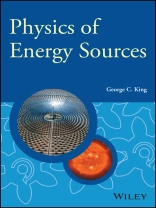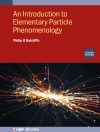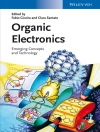Physics of Energy Sourcesprovides readers with a balanced presentation of the fundamental physics needed to understand and analyze conventional and renewable energy sources including nuclear, solar, wind and water power. It also presents various ways in which energy can be stored for future use. The book is an informative and authoritative text for students in the physical sciences and engineering and is based on a lecture course given regularly by the author.
With the ever increasing demand for sustainable, environmentally-friendly and reliable sources of energy, the need for scientists and engineers equipped to tackle the challenges of developing and improving upon commercially viable energy sources has never been more urgent. By focusing on the physical principles governing energy production, storage, and transmission, this book provides readers with a solid foundation in the science and technology of energy sources.
Physics of Energy Sources features include:
- Analyses of conventional and renewable energy sources in terms of underlying physical principles
- Integrated application of a wide range of physics, from classical to quantum physics
- Coverage of nuclear, wind, wave, tidal, hydroelectric, geothermal and solar power, including many practical systems
- Consideration of efficiency for power production as well as energy storage and transportation
- Consideration of key environmental issues
- Worked examples in text, and problems & solutions to encourage understanding
- Derivation of formulae with a minimum of mathematical complexity
Table des matières
Editors’ preface to the Manchester Physics Series xi
Author’s preface xiii
1 Introduction 1
1.1 Energy consumption 1
1.2 Energy sources 3
1.3 Renewable and non-renewable energy sources 5
1.4 The form and conversion of energy 6
1.4.1 Thermal energy sources 7
1.4.2 Mechanical energy sources 7
1.4.3 Photovoltaic sources 7
1.4.4 Energy storage 8
Problems 1 9
2 The atomic nucleus 11
2.1 The composition and properties of nuclei 12
2.1.1 The composition of nuclei 12
2.1.2 The size of a nucleus 14
2.1.3 The distributions of nuclear matter and charge 19
2.1.4 The mass of a nucleus 21
2.1.5 The charge of a nucleus 24
2.1.6 Nuclear binding energy 27
2.1.7 Binding energy curve of the nuclides 30
2.1.8 The semi-empirical mass formula 32
2.2 Nuclear forces and energies 35
2.2.1 Characteristics of the nuclear force 35
2.2.2 Nuclear energies 36
2.2.3 Quantum mechanical description of a particle in a potential well 39
2.3 Radioactivity and nuclear stability 47
2.3.1 Segré chart of the stable nuclides 48
2.3.2 Decay laws of radioactivity 49
2.3.3 α, β and γ decay 57
Problems 2 67
3 Nuclear power 71
3.1 How to get energy from the nucleus 71
3.2 Nuclear reactions 73
3.2.1 Nuclear reactions 73
3.2.2 Q-value of a nuclear reaction 74
3.2.3 Reaction cross-sections and reaction rates 76
3.3 Nuclear fission 82
3.3.1 Liquid-drop model of nuclear fission 83
3.3.2 Induced nuclear fission 86
3.3.3 Fission cross-sections 87
3.3.4 Fission reactions and products 88
3.3.5 Energy in fission 90
3.3.6 Moderation of fast neutrons 92
3.3.7 Uranium enrichment 93
3.4 Controlled fission reactions 97
3.4.1 Chain reactions 97
3.4.2 Control of fission reactions 101
3.4.3 Fission reactors 103
3.4.4 Commercial nuclear reactors 105
3.4.5 Nuclear waste 107
3.5 Nuclear fusion 109
3.5.1 Fusion reactions 110
3.5.2 Energy in fusion 111
3.5.3 Coulomb barrier for nuclear fusion 113
3.5.4 Fusion reaction rates 113
3.5.5 Performance criteria 115
3.5.6 Controlled thermonuclear fusion 117
Problems 3 123
4 Solar power 127
4.1 Stellar fusion 128
4.1.1 Star formation and evolution 128
4.1.2 Thermonuclear fusion in the Sun: the proton–proton cycle 131
4.1.3 Solar radiation 132
4.2 Blackbody radiation 134
4.2.1 Laws of blackbody radiation 135
4.2.2 Emissivity 137
4.2.3 Birth of the photon 141
4.3 Solar radiation and its interaction with the Earth 145
4.3.1 Characteristics of solar radiation 145
4.3.2 Interaction of solar radiation with Earth and its atmosphere 147
4.3.3 Penetration of solar energy into the ground 155
4.4 Geothermal energy 159
4.4.1 Shallow geothermal energy 160
4.4.2 Deep geothermal energy 161
4.5 Solar heaters 162
4.5.1 Solar water heaters 162
4.5.2 Heat transfer processes 165
4.5.3 Solar thermal power systems 172
4.6 Heat engines: converting heat into work 174
4.6.1 Equation of state of an ideal gas 175
4.6.2 Internal energy, work and heat: the first law of thermodynamics 177
4.6.3 Specific heats of gases 181
4.6.4 Isothermal and adiabatic expansion 183
4.6.5 Heat engines and the second law of thermodynamics 185
Problems 4 196
5 Semiconductor solar cells 201
5.1 Introduction 201
5.2 Semiconductors 204
5.2.1 The band structure of crystalline solids 204
5.2.2 Intrinsic and extrinsic semiconductors 208
5.3 The p–n junction 214
5.3.1 The p–n junction in equilibrium 214
5.3.2 The biased p–n junction 217
5.3.3 The current–voltage characteristic of a p–n junction 219
5.3.4 Electron and hole concentrations in a semiconductor 222
5.3.5 The Fermi energy in a p–n junction 227
5.4 Semiconductor solar cells 229
5.4.1 Photon absorption at a p–n junction 229
5.4.2 Power generation by a solar cell 231
5.4.3 Maximum power delivery from a solar cell 235
5.4.4 The Shockley–Queisser limit 238
5.4.5 Solar cell construction 240
5.4.6 Increasing the efficiency of solar cells and alternative solar cell materials 243
Problems 5 248
6 Wind power 251
6.1 A brief history of wind power 251
6.2 Origin and directions of the wind 253
6.2.1 The Coriolis force 253
6.3 The flow of ideal fluids 256
6.3.1 The continuity equation 257
6.3.2 Bernoulli’s equation 258
6.4 Extraction of wind power by a turbine 263
6.4.1 The Betz criterion 265
6.4.2 Action of wind turbine blades 268
6.5 Wind turbine design and operation 271
6.6 Siting of a wind turbine 277
Problems 6 280
7 Water power 283
7.1 Hydroelectric power 284
7.1.1 The hydroelectric plant and its principles of operation 284
7.1.2 Flow of a viscous fluid in a pipe 286
7.1.3 Hydroelectric turbines 288
7.2 Wave power 291
7.2.1 Wave motion 292
7.2.2 Water waves 306
7.2.3 Wave energy converters 319
7.3 Tidal power 324
7.3.1 Origin of the tides 325
7.3.2 Variation and enhancement of tidal range 335
7.3.3 Harnessing tidal power 341
Problems 7 346
8 Energy storage 349
8.1 Types of energy storage 350
8.2 Chemical energy storage 351
8.2.1 Biological energy storage 351
8.2.2 Hydrogen energy storage 351
8.3 Thermal energy storage 352
8.4 Mechanical energy storage 355
8.4.1 Pumped hydroelectric energy storage 355
8.4.2 Compressed air energy storage 357
8.4.3 Flywheel energy storage 361
8.5 Electrical energy storage 364
8.5.1 Capacitors and super-capacitors 365
8.5.2 Superconducting magnetic storage 367
8.5.3 Rechargeable batteries 368
8.5.4 Fuel cells 370
8.6 Distribution of electrical power 372
Problems 8 374
Solutions to problems 377
Index 397
A propos de l’auteur
George King is Emeritus Professor of Physics at the University of Manchester where he is a member of the Photon Physics Research Group. His area of research is Atomic and Molecular physics and he has published more than 200 papers in the scientific literature. He has taught a number of lecture courses in the School of Physics and Astronomy including the course Physics of Energy Sources. Professor King is author of Vibrations and Waves, which is also in the Manchester Physics Series. He has acted as External Examiner in Physics at a number of universities in both the UK and Ireland and as a scientific consultant to industry. He is married to Dr Michele Siggel-King who works in cancer research and his hobbies include playing and listening to music.












